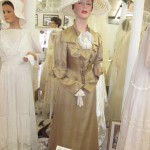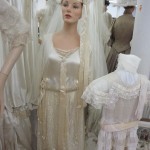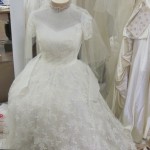One of the most popular displays at the Canal Museum is the Bridal Display which features dresses from the 1890’s through the 1950’s. Although they are beautiful to look at, they also reflect the changes and events of our society. Early weddings in America were generally private affairs, held at the home of the parents of the bride or groom, with an announcement being made in church the following Sunday. Most wedding dresses were made at home or, for the wealthy, by a dressmaker. As the Industrial Revolution (1820-1870) progressed, a definite middle class sprang up; and by the 1890’s almost every bride that so desired could be married in a “new” wedding dress.
The turn of the century saw wedding dresses become increasingly more elaborate until the onset of World War I when supplies were limited. At that time styles became simpler and also reflected the changing role of women in society with hems getting shorter. The typical 1920’s dress was a white knee-length dress that was worn with a long train. A cloche-style wedding veil was also worn.
During the Great Depression, brides either wore their best dress for the wedding or purchased something practical that could also be worn after the wedding. Sometimes it would be a white dress that would be dyed a darker color and sometimes it was simply a suit.
Women felt it was their duty to give up the traditional wedding during World War II. Another factor was the last minute marriage proposals before a soldier was shipped overseas, which did not leave enough time to plan a big ceremony. With the entire nation behind the war effort, a new dress was almost impossible to find anyway, so again, the best dress or suit had to do. If both the bride and the groom were in the military they were married in their uniforms.
The 1950’s was a time of prosperity and wedding dresses included a lot of lace, thanks to the end of wartime restrictions on fabric. They were fashioned after the popular qualities (for women) of the day: sensibility, modesty, and femininity.
The social upheaval during the 1960’s caused many brides to reject the cookie-cutter standards of the 50’s and opt instead for attire (not always a dress) that was unique to them and reflected their personality. It wasn’t until Princess Diana’s wedding in 1981 that the traditional wedding dress came back into vogue as each bride strived to be a princess…at least for a day. Now we have a new princess bride who has set the style with a traditional, yet modern style. What will the next style changing event be?
The Canal Museum is open every Saturday & Sunday from 1 to 3 p.m. and every Thursday from nine to noon. Our new displays are taking shape so stop in for a visit to see the progress we have made.
Printed in the Delphos Herald June11, 2011.
- 1890’s Dress
- 1920’s Dress
- 1950’s Dress















Speak Your Mind